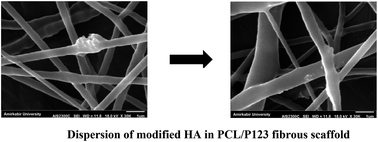Fabrication and characterization of polymer–ceramic nanocomposites containing pluronic F127 immobilized on hydroxyapatite nanoparticles†
Abstract
Functionalized hydroxyapatite nanoparticles (HA-F127) were synthesized by immobilizing pluronic F127 onto hydroxyapatite nanoparticles (HA). Successful grafting of F127 was evaluated by FTIR, TGA and TEM. XRD was used to study the crystalline structure of neat and functionalized nanoparticles. Grafted F127 chains on the surface of HA formed a core–shell structure. Furthermore, immobilization of F127 chains on the HA surface decreased the agglomeration of modified nanoparticles and improved their dispersion. In the next step, the HA-F127 and unmodified HA were introduced into a PCL/P123 electrospun substrate, and nanocomposites containing 4 wt% nano-filler were obtained. The corresponding properties of these polymer/ceramic nanocomposites, including morphology, thermodynamics, mechanics and biocompatibility, were evaluated. HA-F127/PCL/P123 showed superior mechanical performance, crystallinity percentage and thermal stability. The aforementioned improvements were primarily ascribed to a uniform dispersion of HA-F127 and strong interfacial adhesion between filler and matrix, which resulted from superior chain entanglements and interfacial crystallization of modified HA in the polymer substrate. Nanocomposites containing modified HA organized into a reliable platform for adhesion and proliferation of mouse L929 fibroblast cells. Finally, to analyze the interfacial interactions between phases, molecular dynamics simulation was applied. It was found that strong interfacial interactions exist between HA-F127 and PCL/P123. Consequently, HA-F127/PCL/P123 nanofibrous scaffolds can be considered as a promising candidate for tissue engineering applications.


 Please wait while we load your content...
Please wait while we load your content...